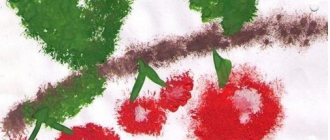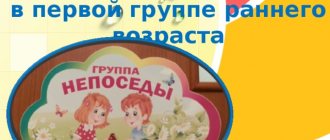MAGAZINE Preschooler.RF
Non-traditional forms of working with children in the organization of educational activities, aimed at the implementation of the Federal State Educational Standards for preschool educationPedagogical article
Author: Irina Viktorovna Nazarenko, Municipal Budgetary Preschool Educational Institution No. 7 “Rainbow”, Altai Territory, Kulundinsky District
teacher Kulunda 2020
Direct educational activities are based on one of the specific children's activities and are carried out jointly with the teacher. This activity is aimed at children mastering one or more educational areas or their integration using a variety of forms and methods of work.
In terms of content, the educational activity itself can be:
Classical - in the old classical form: explanation, completion of the task by children. Results of the lesson.
Combined - a combination of different types of activities or several didactic tasks that do not have logical connections with each other (after drawing there is an outdoor game).
Complex - the implementation of tasks through different types of activities with associative connections between them (a conversation about fire safety rules turns into drawing a poster on the topic). At the same time, one type of activity dominates, and the second complements it and creates an emotional mood.
Integrated – they combine knowledge from different educational fields on an equal basis, complementing each other (considering such a concept as “mood” through works of music, literature, painting), i.e. combine knowledge from several areas. This association is not arbitrary or mechanical. It is necessary to provide for the integration of knowledge in such a way that they complement and enrich each other when solving didactic problems.
Final or test.
This is the traditional classification.
A non-traditional lesson differs from a traditional one: in preparation and conduct; according to the structure of the lesson; on the relationship and distribution of responsibilities between teacher and student; on the selection of educational materials and criteria for their evaluation; according to the methodology for assessing activities.
Many teachers continue to adhere to the structure of a traditional lesson when performing any didactic task, be it the formation of new knowledge or the development of skills. This is explained by the fact that the practical skill of constructing a traditional lesson, developed by teachers over the course of decades, has become a kind of psychological barrier, which can only be overcome by realizing that presentation and consolidation are not the main goal of the teacher and that the lesson can be built on the basis of other goals, according to a different didactic scheme.
The use of non-traditional forms of classes is a powerful stimulus in learning; it is a varied and strong motivation. Through such activities, cognitive interest is activated much more actively and quickly, because the child by nature likes to play. Another reason is that there are many more motives in the game than in ordinary learning activities. Thanks to non-traditional forms of classes, tension is relieved and there is an emotional impact on children, thanks to which they develop stronger, deeper knowledge.
Conducting such classes indicates the attempts of teachers to go beyond the template in building the methodological structure of the educational lesson. Understanding the pedagogical process allows us to identify two main functions of education: the function of transmitting a message, or expressing meaning (teaching educational material according to the program); the function of communication, that is, providing understanding, motivation to action, emotional satisfaction.
Modern teachers carry out the first function relatively easily, having a foundation of special knowledge, methodological literature and recommendations. The functions of ensuring understanding, awakening to learning, and emotional satisfaction within the framework of traditional classes are poorly implemented. Therefore, non-traditional activities compensate for this deficiency.
The significance of such activities is determined, first of all, by the fact that the educational activity itself, aimed in its traditional understanding at the assimilation by the group of students as a whole of the requirements of the educational program, not adequately coupled with creative activity, can, paradoxically, lead to to inhibit the intellectual development of children. Getting used to performing standard tasks aimed at consolidating basic skills that have a single solution and, as a rule, a single predetermined path to achieve it based on some algorithm, children have practically no opportunity to act independently, effectively use and develop their own intellectual potential. On the other hand, solving typical problems alone impoverishes the child’s personality, since in this case the high self-esteem of children and the assessment of their abilities by teachers depends mainly on diligence and diligence and does not take into account the manifestation of a number of individual intellectual qualities, such as invention, quick wit, ability for creative search, logical analysis and synthesis. Thus, one of the main motives for using non-traditional activities is to increase the creative and exploratory activity of children, which is equally important both for pupils whose development corresponds to the age norm or is ahead of it (for the latter, the framework of the standard program is simply too tight), and for children requiring special correctional work, since their developmental delay and, as a consequence, reduced academic performance in most cases are associated precisely with the insufficient development of basic mental functions.
Non-traditional classes have their own order of work:
— The teacher must present the selected material in an interesting, unusual form. Rational alternation of activities involves replacing one type of activity with another. In this case, each new routine moment turns into a kind of rest, active, relieving fatigue caused by previous activity.
- A variety of activities should be used in such a lesson. The tasks should be feasible for children, but not too easy.
- Children should receive emotional satisfaction from the activity.
- The tasks should force children to think, try, make mistakes, and finally find the correct answer.
According to the goals and content of training, the position of the teacher in the educational process, and the nature of his activities, principles, methods and forms of teaching change. In non-traditional teaching, the teacher’s activity changes radically. Now the main task of the teacher is not to “convey” , “present” , “explain” and “show” to the students, but to organize a joint search for a solution to the problem that has arisen before them.
Creative principles help to understand the main thing in a non-traditional activity:
- The principle of an individual approach to students. It requires constructing a lesson taking into account the personal needs of children, creating conditions for the development of their individual inclinations, interests, and inclinations.
- The principle of connection between theory and practice. Requires a closer connection between non-traditional forms of education and regular classes: theoretical and practical material receives additional confirmation.
- The principle of consciousness and activity. It involves creating conditions for the student to become interested in the lesson, creative activity in its preparation and implementation, and satisfaction with its results.
- The principle of selectivity. It involves the selection of forms, methods and means of conducting non-traditional classes, taking into account age and preparedness, and whether they have interests in classes.
- The principle of connection between theory and practice. It involves revealing the practical significance of the knowledge, skills and abilities they acquire in the classroom.
- The principle of voluntary participation in activities. It assumes that children have a specific range of interests, which allows them, among many types of activities, to choose the one that best suits their internal needs.
Guided by such principles, the teacher sets the general direction for pedagogical creativity and focuses on very specific teaching activities: rejection of the template in organizing the lesson, from routine and formalism in its implementation.
It is necessary to maximize the involvement of students in active activities in the classroom, the use of various forms of group work, support for alternativeness, plurality of opinions, and the development of the communication function - as a condition for ensuring understanding, motivation to action, and a feeling of emotional satisfaction.
Forms of conducting non-traditional training sessions:
- Excursion. To the library, studio, post office, field, construction site, school, etc.
- Collective creative activity: collective drawing, collective appliqué, etc.
- Occupation-work: planting onions, cutting plants, planting seeds, etc.
- Activity-game: “Toy store” , “Let’s arrange a room for the doll” . Option: Auction activity “Whoever tells you more about an item buys it,” etc.
- Creative activity: workshop of an artist, folk craftsmen, storyteller, “Workshop of Good Deeds” (crafts made from waste, natural materials, paper crafts using TRIZ elements).
- Activities-gatherings: using folklore material, against the backdrop of work, children sing, make riddles, tell fairy tales, and dance in circles.
- Lesson-fairy tale: the whole lesson is based on the plot of one fairy tale, using music, visual arts, and dramatization.
- The lesson is a press conference: children ask questions to the “cosmonaut” , “traveler” , “fairy tale hero” , and he answers the questions. Then the “Journalists” draw and write down what interests them.
- Landing lesson: emergency assistance. (For example: during drawing, we ask children about what they can’t do or do poorly. Today we will draw it, those who are good at it will help us. Option: a joint activity for children of the older and younger groups (co-creation). Elders, k For example, they make a background, the younger ones draw what they can.
- Commented teaching lesson: the whole group of children is given a task - forming the number “7” . One of the children speaks out loud how he makes up a given number, the rest silently do it; if the speaker makes a mistake, a discussion begins. Or the teacher places pictures on the board, the children comment on the image, and make up a story. There are many options you can come up with.
- Lesson - journey: goal - to develop children's monologue speech. One of the children is a “tour guide” , the rest of the children ask questions. Options: travel through fairy tales, native country, city, republic, to the “Land of Fun Mathematics” , according to the “Red Book” , etc.
- Lesson - experiment: this is a favorite experimental activity for children.
- Activities - drawings - essays: the teacher draws, the children compose stories based on their drawings. Children write a letter - a drawing about an event in kindergarten.
- The activity is a competition: like “What, where, when?” . This is a competition for dreamers, poems, and fairy tales. Sports competitions - competitions.
- Activity – game – school: schools for astronauts, athletes, forest dwellers, school for young pedestrians, etc.
- The activity is a concert.
Despite the variety of such classes, they all must meet some general requirements, the observance of which helps to increase the effectiveness of teaching: the teacher must clearly formulate the topic and purpose of the lesson, each lesson must be teaching, developing and educating, the lesson must be a combination of collective and individual work of students . It is necessary to select the most appropriate teaching methods, taking into account the level of preparedness of children, and also take into account the fact that the learning of educational material must be carried out in the classroom using health-saving technologies.
Thus, non-traditional classes are classes that differ in the organization of activities, in the structure of content, in their use in training
In recent years, interest in non-traditional forms of conducting preschool education classes has increased significantly. This is due to various transformations, the active implementation of various pedagogical innovations, proprietary programs and methodological recommendations into practice.
So, non-traditional activities are extraordinary approaches to learning; these are always holidays when all children are active, when everyone has the opportunity to express themselves in an atmosphere of success. These classes include a wide variety of forms and methods, especially such as problem-based learning, search activities, interdisciplinary and intradisciplinary connections. Tension is relieved, thinking is enlivened, interest in the educational program as a whole is excited and increased.
| Next > |
Summaries of non-traditional physical education classes by age
Notes of non-traditional physical education classes
by age
Summary of a non-traditional physical education lesson in the second junior group “The kids have become little frogs”
Target:
to form motor skills in children, to develop psychophysical qualities.
Tasks:
1) improve crawling under an arc, jumping into a hoop from a hoop, imitating the movements of frogs, walking like a snake;
Equipment:
box, frog toy, 2 arcs, 6 pins, 3 hoops, ribbons, frog hats according to the number of children in the group.
Progress of the lesson
Come closer to me. I'll show you something. You often meet an unusual animal. It is on the path, sometimes jumps out on the path, looks at you with its bulging little eyes and tries to hide again in the wet grass. And sometimes he jumps so fast that you can’t catch up. And when “kva-kva” starts talking, everyone recognizes him by his voice. Guess who's in my box! (toy) That's right, frog! Admire how smooth and slippery his suit is. And what color is it! That's right, green. Did everyone get a good look at it? I will put the open box on the ground, let the little frog jump in the grass and tell the mother frog how he visited us. This is how the little frog jumps quickly. Wave your arms at him.
Now put on your frog hats. Ready! Everything is fine! Let's start practicing, we will repeat the movements of the frog and do everything beautifully.
We walked one after another in a circle with our “paws” - we bent our arms at the elbows and spread them in different directions, we raised them up, lowered them down and even rotated them.
Slowly we ran after each other, moving our paws through the air. So we run, we look under our feet
We stopped. “Paws” - arms extended forward, turn them around, look at them on one side, on the other, clap your hands
They ran after each other again, faster, with their paws bent at the elbows and clapping their palms at the top.
They stopped, put their paws on my cheeks, turned their heads lightly to the side, and that’s it, everyone looked at me carefully
Open it wide, inhale, take in a lot of air and close your mouth. Now we calmly release it through the nose.
Warm-up with seaweed (bands).
Well done, “little frogs”! Everything was done well. Can I complete the next task? Of course yes! Then we’ll all say “kwa, kwa, kwa!”
We’ll crawl under the arches, and when we straighten up, we’ll say, “kwa, kwa.” And now to jump from hoop to hoop, we also say “kwa, kwa.” Walk in a “snake” between the pins.
Everyone walked the difficult path; They didn’t hit anything, they managed to do a lot, even more than the frog. For this you are entitled to a gift - a game. And it's called "Frogs"





